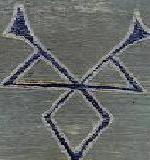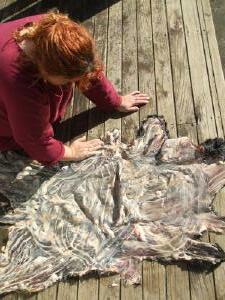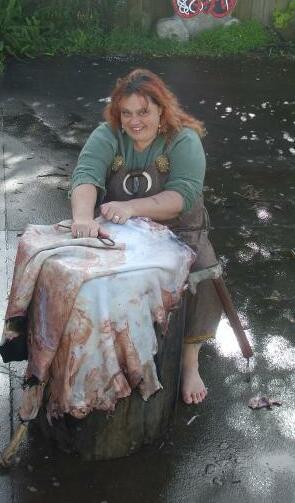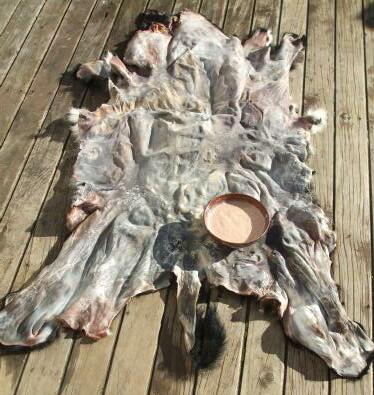 |
|
|
|
| Author |
Message |
sage
Location: picton
|
 Posted: Mon Oct 06, 2008 7:37 pm Tanning Posted: Mon Oct 06, 2008 7:37 pm Tanning |
 |
|
Just wondering if anyone knows some good recipes for home tanning
as i have been goat hunting and have got some nice skins that i want to
make a cloak out of.
thanx Sage
_________________
HAVE NO FEAR OF DEATH! WHEN ITS OUR TIME! ODEN WILL BRING US H0ME! WHEN WE DIE |
|
|
 |
adrianf

Location: palmerston north
|
 Posted: Mon Oct 06, 2008 8:00 pm Posted: Mon Oct 06, 2008 8:00 pm |
 |
|
in one of the recent NZ hunting and fishing magazines there was a home recipe. i think it was the july edition
_________________
surrender to temptation, you never know when it will come your way again |
|
|
 |
huscarl

Location: in the back of your mind
|
 Posted: Mon Oct 06, 2008 9:47 pm Posted: Mon Oct 06, 2008 9:47 pm |
 |
|
Try baking soda and kero mix till you have a paste and rub on to a dry scraped and stretched skin til it sets about 5mil thick let sit for 4 or 5 days till hard then scrape or wire brush off repeat stick in washing michine (dont get caught by whife) dry and brush rub around a poast or tree till soft good as and can be left outside for ages and it will be good as. 
_________________
hail Fraja. |
|
|
 |
Dreyrugr

Location: Auckland
|
 Posted: Mon Oct 06, 2008 10:43 pm tanning Posted: Mon Oct 06, 2008 10:43 pm tanning |
 |
|
I used 3 sheep brains and half a cup of strong tea(tannin 3x teabags)
placed into blender until you get a lovely strawberry milkshake looking gloop.... very sticky and watch out for the bits that havnt blended.... eeky.
It is said that the brain of the animal you skin should have enough tannin to tan itself. If that makes sense.
Mine was a calf skin and it has finished up nicely.
| Description: |
|
| Filesize: |
19.81 KB |
| Viewed: |
16253 Time(s) |

|
| Description: |
|
| Filesize: |
28.03 KB |
| Viewed: |
16253 Time(s) |

|
| Description: |
|
| Filesize: |
37.36 KB |
| Viewed: |
16253 Time(s) |

|
_________________
are you really what you think you are? |
|
|
 |
Boyd

Location: London
|
 Posted: Tue Oct 07, 2008 7:29 am Posted: Tue Oct 07, 2008 7:29 am |
 |
|
This is a great site -
www.braintan.com/
_________________
Experience is not what happens to a man; it is what a man does with what happens to him.
Aldous Huxley in "Texts and Pretexts", 1932 |
|
|
 |
Colin & Lynlee

Location: N Z & NSW
|
 Posted: Tue Oct 07, 2008 9:00 am alum method variation Posted: Tue Oct 07, 2008 9:00 am alum method variation |
 |
|
I have done a couple of deer hides. I don't think I worked them enough but they are not rotting. I have a friend at leather and shoe research who said Alum is as good as any for home use. Some of the other methods may get up the nose of close neighbours - literally.
I looked at buying alum at the chemist -- Ouch!! So I looked around for the chemical elsewhere and discovered alum based pool floc was way cheaper.
I just made up a solution About 1/3 bottle into a black rubbish bin. Put the hide in it and moved it around with a stick morning noon and night for a week.
Then I rubbed laundy powder onto the back and rinsed really well before stretching, working and oiling..
The young guy at the Para shop asked if I had a spa or cold water pool. He was a little surprised when I said Deer Hide!!!
Lynlee
_________________
Where there is much desire to learn, there of necessity will be much arguing, much writing, many opinions; for opinions in good men is but knowledge in the making.
John Milton
English poet (1608 - 1674) |
|
|
 |
sage
Location: picton
|
 Posted: Tue Oct 07, 2008 11:42 pm Posted: Tue Oct 07, 2008 11:42 pm |
 |
|
Kool thanx for all the help guys
Sage
_________________
HAVE NO FEAR OF DEATH! WHEN ITS OUR TIME! ODEN WILL BRING US H0ME! WHEN WE DIE |
|
|
 |
amuckart
Location: Wellington
|
 Posted: Wed Oct 08, 2008 10:13 am Posted: Wed Oct 08, 2008 10:13 am |
 |
|
There have been three different, and slightly contradictory, processes described in this thread so far so I'll try and disentangle them a little.
Discounting chrome tanning, which is a large scale modern industrial process, there are three main ways to cure rawhide into a stable leather. In all of them the intent is to get the fats and water out of the leather and replace them with something that doesn't rot and is flexible and stable. Some of them also affect the actual protein fibres the skin is made up of changing the chemistry of the skin fairly significantly.
Vegetable tanning: Traditionally done very slowly (weeks/months) using tannins obtained from bark or wood, modernly done rapidly (24h) with manufactured concentrated tannins.
Oil treatment: Uses the oxidation of lipids and fatty acids in brains or other oils and optionally also the preservatives in woodsmoke to stabilise hide. Doesn't normally employ any tannins. End product is chamois or buckskin and has the unique property of being completely stable in water, hence it's use for washcloths for cars and 19th century cattlemen's long coats. I believe the kerosene and baking soda method mentioned earlier is a variant on this.
Alum tawing This is an ancient process where rawhide is stuffed with aluminium salts, salt, and an emulsion. It produces bright white, very strong hide that is generally very unstable in water. Traditionally used for bindings of high-quality books, and was used for some shoes, purses, gloves etc in medieval Europe.
Of these, only vegetable tanning is a true "tanning" of the hide into leather. The others do stabilise the hide against rot, but the end product isn't technically called "leather" despite the fact that everyone tends to call it that.
The easiest, if squickiest, one to do at home is probably oil or brain tanning, followed by alum tawing. I'll second Boyd's recommendation to go and look at http://www.braintan.com, it has a lot of good information. Note though that I'm not aware of any evidence[1] for the use of brain tanning pre-modern Europe. It was widely used in the Americas, but that doesn't necessarily translate to known use in Europe. Identifying the tannage of archaeological leather is difficult, if not impossible, since anything left in the ground for 600 years pretty much ends up veg tanned by default if it survivies. This means it's possible it was used, but I'm not aware of any documents that mention it or any surviving infrastructure or samples associated with it.
There is some good information about alum tawing courtesy of J. Hewit & Sons here.
Contrary to common conception, the disgusting, smelly, and difficult portion of tanning a hide isn't the tanning, it's the de-fleshing and de-hairing. On smaller skins like rabbit, and things cured with the hair on for furs, this is fairly straightforward but on larger hides that you need to get the hair off of it's a lot of very stinky hard physical work.
For de-fleshing you ideally need a fermented bran solution (acidic) in which you soak your hide for a day or a week, then put it over a beam and use a fleshing knife (sort of like a slightly blunt drawknife) to scrape the remaining flesh and fatty bits off of the inside of the hide. Neither the fermented bran solution nor the rotting fleshy bits of the hide are much fun to be around by all accounts.
De-hairing involves soaking the hide in a solution of lye (alkaline) to weaken the hairs and dissolve the follicle matter. In medieval London the best lye for this purpose was made from the ash of burned dry, white dogshit. This process doesn't smell terribly good either. After soaking in the lye water it's back to the beam to scrape off the hairs.
Once all this is done, and the skin is rinsed and neutralised with another dip in the acid solution then subjected to whatever curing process is decided on. With traditional pit tanning using bark tannins the hide is soaked in vats of increasing strength until it is tanned all the way through. This is not a trivial process to get just right, and based on the archaeological evidence the results achieved medieval tanners were often a bit suboptimal by modern standards. Pit tanned leather is quite a different substance from modern vegetable tanned leather. It behaves quite differently in terms of stretch, substance, hand, and wearability. Generally it is stiffer and tougher when dry but softer and more flexible when wet than modernly vegetable tanned leather. Sadly it's also next to impossible to get hold of and a huge amount of work to produce on a small scale.
If you have access to the Wellington central library there are some good books on small scale tanning in there, as well as a copy of Ancient Skins, Parchments, and Leathers which is an excellent, if dry, resource that is incredibly rare and expensive to buy.
Irrespective of the method used, freshly cured and dried hides come out of the process stiff as a board and pretty much unusable. They need to be be curried which is the process of 'breaking' the hide over a stake or breaking knife to loosen up the fibres, paring them down to an even thickness as required, stuffing them with oils and fats[3], and applying whatever surface finish is required. Currying is a very separate trade from tanning in most places.
[1] "But the Indians have been using it for centuries[2] so other cultures must have done too!" doesn't count as 'evidence'. Sorry.
[2] At least 3, maybe 4.
[3] A mix of tallow and cod liver oil is a traditional and still excellent treatments for vegetable tanned leathers.
_________________
Al Muckart. Shoe geek.
http://wherearetheelves.blogspot.com |
|
|
 |
Boyd

Location: London
|
 Posted: Wed Oct 08, 2008 1:55 pm Posted: Wed Oct 08, 2008 1:55 pm |
 |
|
Straking is very important - don't forget this - my B/tanned sheepskins are not as flexible as they could be.
The Braintan.com website also identifies some issues specific to goat skins
Here's a doc I prepared for the WMG newsletter after I had B/T some sheepskins
| Description: |
|

Download |
| Filename: |
Adventures in Brain Tanning.doc |
| Filesize: |
40 KB |
| Downloaded: |
1037 Time(s) |
_________________
Experience is not what happens to a man; it is what a man does with what happens to him.
Aldous Huxley in "Texts and Pretexts", 1932 |
|
|
 |
|
|
 Please read the terms of use
Please read the terms of use
 Contact the Site Admin
Contact the Site Admin




